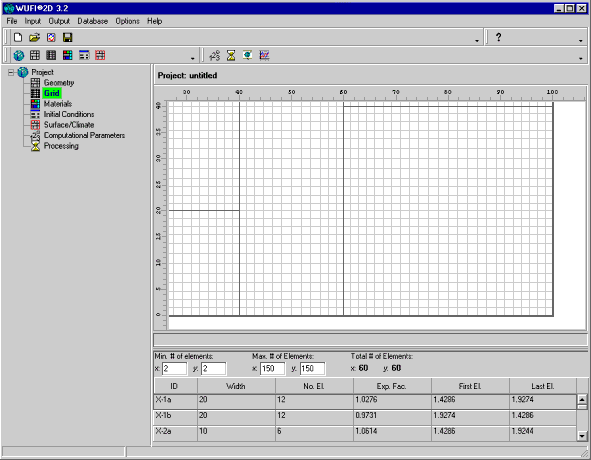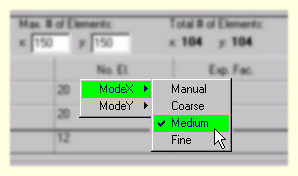2D:Dialog Grid
Dialog: Grid
Use this dialog to specify the numerical grid for the component.
The transport equations cannot be solved analytically. To allow a numerical
treatment, the building component must be divided into discrete grid elements.
WUFI can automatically generate a general-purpose grid which will suffice for
most cases (you can select one of three degrees of fineness for the grid).
In special cases (e.g. severe interstitial condensation in a narrow region) you
may need to adapt the grid manually.
WUFI subdivides the component into a succession of layers in x and y direction.
The widths of the individual layers are determined by the
geometry of the component.
For each layer, its grid is defined by specifying the number of grid elements
in that layer and an expansion factor. The expansion factor is the ratio of the
thicknesses of two adjacent grid elements in the layer. An expansion factor
different from 1 will result in a smoothly expanding (>1) or contracting (<1) grid.
A table in the lower part of the dialog lists the layers and their widths,
and for each layer the number of grid elements, the expansion factor and the
resulting thickness of the first and last grid element in the layer.
Usually, WUFI automatically determines all these quantities by itself, but you can also manually adjust the grid parameters of each layer (see below).
For the discretisation of the transport equations, the values of the calculated
temperatures and humidities are assumed to be constant across each grid element.
Therefore, the size of
each element should be chosen so as to make this assumption approximately valid,
taking the local conditions into account. In general, this requires the use of small
elements in regions where steep moisture or temperature gradients are to be expected,
and allows the use of larger elements in more placid regions to cut down on calculation
effort.
In general, steep gradients are to be expected close to the boundaries of a layer,
i.e., close to the surfaces of the component because of the influence of climate
conditions, and close to internal material interfaces because of condensation. Less
variation will occur in the middle of each material.
WUFI therefore subdivides the component into layers in such a way that there is
always an even number of layers between two material interfaces. The automatic grid
generator then chooses expansion factors which are alternately greater and less than 1,
thus creating a grid which expands in the middle of a material and contracts towards
material interfaces.
Min. # of elements,
Very thin materials will only contain a very small number of grid elements. Here you can specify the minimum number of grid elements allotted to a layer by the automatic grid generator . Reasons for wanting a higher minimum number of elements may be, among others:
- your component contains a thin membrane whose vapor permeability depends on its moisture content (e.g. a polyamide membrane). The moisture profile across the membrane should then be resolved faithfully enough so that the total vapor permeability can be determined accurately.
- you have a thin material in the component whose material parameters differ markedly from the materials around it (e.g. a vapor barrier). In order to determine the heat or vapor flows between adjacent grid elements, WUFI must combine the heat conductivities or vapor permeabilities of both elements into one single conductivity value describing the effective conductivity between the grid element centers. If the elements belong to materials with markedly different material properties, this results in "smearing" part of each material into the neighboring material. While confined to the edges of the materials, in thin materials this affects a relatively large part of the whole construction element and may affect its properties, e.g. the permeance of the vapor barrier. Increasing the number of grid elements limits this averaging effect to a smaller portion of the construction element. Max. # of elements, Enter here the maximum number of grid elements that is available for distribution across the component. Fine grids will try to use all of these elements, medium and coarse grids will use proportionately less. You may increase this number in order to get a finer grid, you may decrease the number (within limits) to speed up the calculation. Total # of elements: WUFI tells you how many grid elements were actually used for the grid.
Right-click on the data table to access options for the automatic grid generation or switch to the manual editing mode:
ModeX,
ModeY:
For the x or the y direction, select between three degrees of fineness
for the automatic grid, or activate the
manual grid editor mode.
Coarse
Medium,
Fine:
Select between a coarse, medium or fine grid. WUFI is in general quite robust with respect to the choice of the grid. Finer grids are only needed when fine details in the temperature or moisture fields need to be resolved, or when coarse grids create numerical problems.
Manual:
If you need more control over the grid, you may manually specify the grid in x- and/or y-direction by entering the desired number of elements and expansion factor for each layer. For numerical reasons, the widths of adjacent grid elements should not be too different. So please use only moderate expansion factors, and refer to the widths of the first and last element of each layer in order to achieve a smooth continuity of grid element widths across layer interfaces.

